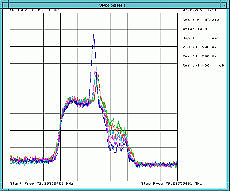Keeping the Tevatron's cool: A look back at electron cooling

This e-log from 2005 indicates the first interaction between electrons and antiprotons.
When electron cooling was implemented at Fermilab in 2005, scientists thought it could help increase the peak luminosity by a factor of 1.5 to 2.
Now, less than a decade later, it has become integral to the Tevatron's success, leading to an increase of instantaneous initial luminosity by nearly a factor of 3.
"The successful implementation of electron cooling has had a larger effect on the initial luminosity for the Tevatron than any other single improvement," said Accelerator Division head Roger Dixon.
Electron cooling condensed the beam to make it easier to manipulate and accelerate, but it also encouraged adjustments to the entire accelerator complex, which was optimized to work well with the new system. It provided additional cooling beyond that carried out in the Accumulator, the accelerator that collects antiprotons, to the Recycler. This enabled the Accumulator to collect antiprotons at higher rates, which translated to more collisions.
"I would say that without electron cooling, the Tevatron wouldn't be running now," said Fermilab electron cooling pioneer and scientist Sergei Nagaitsev. "We wouldn't have enough luminosity to sustain Run II."
Getting to cool
Russian-born scientists Sergei Nagaitsev and Sasha Shemyakin worked on electron cooling as graduate students at the Institute of Nuclear Physics in Novosibirsk, Russia, where electron cooling was pioneered. Nagaitsev came to the laboratory in 1995 specifically to develop the Recycler electron cooling system. He knew the technology could work, just not exactly how to make it work at the high energies necessary for the Tevatron.
"Many people didn't think that this scheme of high-energy electron cooling was possible," Nagaitsev said.
While it seemed like a long shot to some, Nagaitsev spent 10 years leading a small team in designing, testing and then implementing the system. Part of that effort included developing a new beamline, cooling and solenoid technologies. They created a full-scale prototype at Fermilab's Wideband lab and then, once they had operated a stable beam for 24 hours in 2004, moved it and reassembled it in its current home as part of the accelerator complex.
During the electron cooler commissioning, the team members worked shifts almost around the clock to get the system up and stable.
In the summer of 2005, the team had finally achieved a stable electron beam, and it produced nearly immediate results. On July 9, 2005, when experts were studying in parallel the cooler and a new procedure in the Recycler, they began to see a sharp peak in the antiproton momentum distribution - a clear indication of interaction between beams.
"Knowing that the system was working was one of the top moments in my life," said Shemyakin, who was on shift that day.
Nagaitsev attributes the system's success to determination and hard work, but also to intuition and a lot of trial and error.
"The executive decisions we made, even without a lot of information, turned out to be key to the entire project," Nagaitsev said. "We didn't know how important these decisions would be."
For example, he explained, they decided to add a flange to the Pelletron, the 5 million volt electrostatic accelerator that prepares and dispenses electrons, hence dividing the pressure vessel in two halves. The standard version comes as a single cylindrical tank. That allowed them to lengthen it later, which was integral to making the process work.
Present run
Once the machine was commissioned, the team worked to improve and keep it at peak performance. However, similar to other machines at Fermilab that are custom-made and involve thousands of parts, electron cooling's success is occasionally interrupted. When the electron cooling system is down, it affects the entire complex.
"We always welcome it back after the electron cooling crew finishes some critical repairs or maintenance," said Paul Czarapata, deputy head of the Accelerator Division.
When something does go wrong, it falls to a dedicated group of individuals who work around the clock on getting the system back up. The group includes two scientists working full time on the system, Shemyakin and Lionel Prost, who have helped keep it running for the past 7 years. They love the challenge.
"In our business, if you feel that you are clever and can predict how something will behave, then you come to the control room and see that you're wrong," Shemyakin said. "The hardware really tests your abilities."
Currently, thanks in part to the electron cooling system, the Tevatron is running better than ever, a situation that makes the shutdown of the Tevatron and the cooling system on Sept. 30 hard for many.
"I've worked with beams all of my life," Shemyakin said. "It is interesting, and there are always new questions and new techniques to explore."
Although Prost is looking forward to new projects, he is dedicated to making the electron cooling system run well until the very end. There are currently no plans for the system to be incorporated into other experiments, but Nagaitsev explained, there are always future possibilities.
When the system shuts down, Shemyakin and Prost will transition to working on the proposed Project X. The transition, they said, will be bitter sweet.
—Rhianna Wisniewski
|